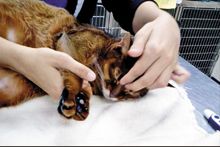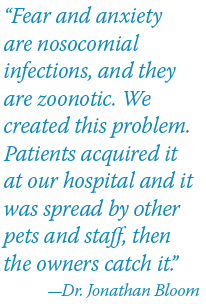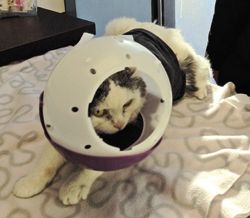5 ways to get started with Fear-Free veterinary practice
This Toronto hospital has clients beating down the doors requesting a lower-stress approach to veterinary care.

Getty Images/George PetersIn an uncertain economic climate when veterinary visits are on the decline, Willowdale Animal Hospital in Toronto is enjoying unprecedented success. Clients are raving, staff morale is the highest it's ever been and business is booming. Instead of cajoling and pleading with clients to bring their pets through the doors, Jonathan Bloom, DVM, has them lined up with smiles on their faces. Many practices with excellent staff and medicine are struggling these days, but Bloom's hospital has a secret ingredient: It has embraced the concept of Fear-Free practice, and as far as Bloom is concerned, you should too.

Dr. Jonathan Bloom“I started about seven or eight years ago,” says Bloom, who will be speaking at CVC Kansas City Aug. 30. “It started with x-rays. I looked at my staff and saw that they'd have to take a whole bunch of views to get two good images.”
Wondering how he could improve their efficiency, he investigated. “I realized dogs and cats don't like having x-rays taken. There's nothing natural about being in a dark room, on a hard, cold table, having your limbs held in four different directions with the viselike grip of lead-lined gloves by people wearing aprons and collars.” He decided to try a different approach.
Bloom implemented a policy that no pet would be restrained for radiographs. “They're either so sick they don't move, or they're going to be sedated,” he says. The results were immediate. “There were no retakes, the pets weren't stressed, and it was better for the staff,” who reduced their radiation exposure while becoming more efficient.
Don't miss the videos!
Be sure to check out the last page of this article to see Fear-Free tools in action with real patients in Bloom's practice.

Happy with the results and the owner responses, Bloom made his next decree: “Don't give owners an update from the phones in the ICU. No one wants to hear screaming cats.” About an hour later, Bloom says, he reflected on what he had just said and realized that was the wrong approach. “We shouldn't be letting pets get that upset in the first place,” he says.
Bloom started to ask himself and his team the following: If the pet could talk, what would he or she say? It wasn't that hard to figure out. “We create mental health problems,” he says. “If you need two 150-pound people to trim the nails on a 10-pound pet, that's a problem.”
Bloom and his staff began experimenting with various techniques to give pets a less stressful experience, and they were buoyed by a receptive client response. “Pet owners may not be able to identify dental disease or obesity, but they are experts at identifying fear and anxiety in their pets,” he says. “Owners are on it. They are grateful for any effort made to help their pets.”
He finds the veterinarians harder to convince than the owners-at least at first. “Here's the problem with training vets: They will spend a day learning the best insulin for the two diabetic pets they see a year. But five of the next 10 patients will be suffering fear and anxiety,” he says.
It took some time, but the other veterinarians at Willowdale also came on board. When they did, Bloom says, the wait was worth it. “It's fun to watch them get it,” he says. “They go from skeptical to ‘That was sort of neat!'”
During the last seven years, Bloom's team has developed a multimodal approach to Fear-Free veterinary practice. With nine other veterinarians on staff, finding common ground and common purpose was challenging at first. “Not everything works every time,” he says. “If Plan A doesn't work, it doesn't mean there's no treatment; it just means we need a different approach.”
Here is Bloom's toolbox of techniques that have worked wonders in his own clinic.
1. Create a Fear-Free culture

In Bloom's practice, everyone has a role to play in creating the right environment for pets and owners, and every employee is encouraged to give input on how to minimize patient stress. No part of the patient-client experience is left unexamined, from the choice of vaccines to the way appointments are structured. Here's what Willowdale has done to maximize calm most successfully.
> Designate dog- and cat-only examination rooms. Pets, especially cats, are often overstimulated when visiting the veterinary hospital. Imagine the experience of an indoor-only cat from the car ride to the hospital-different lighting, different colors, different sounds and different smells. Let's at least try to keep cats in an as familiar environment as possible by providing cat-only rooms. If you're a small practice with limited number of exam rooms, there's an alternative, Bloom says: cat-only appointment hours. “There's no reason a one-doctor practice can't designate 2 to 4 p.m. once a week as cat-only appointment hours,” he says. Many cat owners will choose to come in at other times, but those owners with highly fearful cats will appreciate that option.
> Keep doctors on time. Veterinarians at Willowdale make running on time a priority so as to reduce clients' and patients' waiting time in the exam rooms. But if a delay is unavoidable, a few minutes for pets and owners in the quiet environment of an exam room is preferable to the waiting area.
2. Have the appointment begin at home
The front desk team at Willowdale sends out reminders a week in advance with a list of ways for clients “to make their pet's visit an enjoyable experience.” Bloom has found that empowering clients to take action ahead of time creates a very effective partnership. Owners are instructed to do the following:
> Bring pets hungry. When medically appropriate, withhold food for several hours before an appointment so the patient is highly food-motivated.
> De-stress the carrier. Make the carrier a fun place to be: use it as a regular place to feed treats, deliver toys and spray it with pheromones such as Adaptil or Feliway.
> Use tools. Bring calming items such as Thundershirts along to the appointment if clients own them.
> Bring prescribed pills and chewables. Be ready with sedatives if the pet normally requires them.
> Acclimate nervous patients. If Bloom senses that a pet is anxious during an appointment, he encourages the owner to bring the pet to the hospital between appointments to play and eat a few treats to create a positive association. Another idea-one that Bloom says his practice doesn't do but should-is to have clients bring all new patients into the clinic several days before the appointment to let them play in the hospital.
3. Control pets by minimizing stress instead of maximizing restraint
As far as Bloom is concerned, the less restraint, the better. Here are some of his favorite environmental modifications and tips:
> Lots of food treats throughout the entire appointment. Watch the video below to see Bloom use this technique with both a canine and feline patient:
> Calming music, such as “Through a Cat's Ear,” in the exam rooms.
> Pheromone diffusers placed throughout the hospital.
> Massage on the pet's head. Here's an example of how this works on Bloom's patient Raven:
> Clipnosis, a small plastic scruff clip that resembles a chip bag clip. (See its effect on one patient in the video below:)
> Vaccines that lower stress during administration-for example, the new oral transmucosal Bordetella vaccine rather than the intranasal or injectable forms. Bloom has also started using a half-volume injectable in certain cases. “Owners appreciate that,” he says.

Phoebe wears an air muzzle instead of a tightly fitting piece of cloth over her head. Photo courtesy of Dr. Jonathan Bloom.> Air muzzles for cats and small brachycephalic dogs: instead of a tightly fitting piece of cloth that covers the eyes, the air muzzle is a ball that resembles a deep diver's helmet, with an opening in the front so the pet can see while keeping the head safely enclosed (see photo at right).
> Early use of sedation in those pets who need it.
4. Use effective calming products
Over the years, Bloom's team has accumulated a variety of products for use in the hospital and at home. As an added bonus, when clients see how well pets respond to them, they often purchase the items to use on their pets at home. Two of his favorites are Thundershirts-Bloom keeps a loaner set for clients to borrow as well as a set for sale-and pheremone products Feliway and Adaptil.
Check out the difference a Thundershirt makes during Caramel's physical exam with Bloom:
5. Administer anti-anxiety medications
For pets that don't respond to the above techniques, Bloom doesn't hesitate to use anti-anxiety drugs, which reduce his patients' stress levels without making them less alert. His preferred medications are:
> Trazadone for dogs.
> Gabapentin for cats-“100 mg two hours before the appointment and that cat will be a different pet when they arrive,” Bloom says.
> Diets such as Hills c/d Multicare Feline Stress and Royal Canin Calm.
> Natural products such as Zylkene (a casein-derived relaxation agent) and Anxitane (L-theanine).
For veterinarians who are resistant to the idea of changing the pet experience, Bloom reminds them that pet fear and stress are one of the major factors keeping clients away from the hospital, and it's one of the easiest to fix. “Fear and anxiety are nosocomial infections, and they are zoonotic. We created this problem. They acquired it at our hospital and it was spread by other pets and staff, then the owners catch it,” he says.
He likens the change to what happened in pediatric human medicine in the last several decades, when doctors realized the patient's experience was just as important as the medicine provided. “When puppies come into my practice, they aren't coming in nervous,” he says. “We can make it the best experience possible, or we can make it what 40 to 50 percent pets are experiencing today.”
Dr. Jessica Vogelsang, a certified veterinary journalist, is a regular contributing writer for a number of publications, author of the memoir All Dogs Go to Kevin and creator of the popular blog Pawcurious.com.